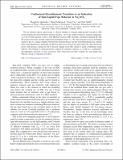| dc.contributor.author | Alpichshev, Zhanybek | |
| dc.contributor.author | Mahmood, Fahad | |
| dc.contributor.author | Cao, Gang | |
| dc.contributor.author | Gedik, Nuh | |
| dc.date.accessioned | 2015-01-20T16:32:47Z | |
| dc.date.available | 2015-01-20T16:32:47Z | |
| dc.date.issued | 2015-01 | |
| dc.date.submitted | 2014-05 | |
| dc.identifier.issn | 0031-9007 | |
| dc.identifier.issn | 1079-7114 | |
| dc.identifier.uri | http://hdl.handle.net/1721.1/92979 | |
| dc.description.abstract | We use ultrafast optical spectroscopy to observe binding of charged single-particle excitations (SE) in the magnetically frustrated Mott insulator Na[subscript 2]IrO[subscript 3]. Above the antiferromagnetic ordering temperature (T[subscript N]) the system response is due to both Hubbard excitons (HE) and their constituent unpaired SE. The SE response becomes strongly suppressed immediately below (T[subscript N]). We argue that this increase in binding energy is due to a unique interplay between the frustrated Kitaev and the weak Heisenberg-type ordering term in the Hamiltonian, mediating an effective interaction between the spin-singlet SE. This interaction grows with distance causing the SE to become trapped in the HE, similar to quark confinement inside hadrons. This binding of charged particles, induced by magnetic ordering, is a result of a confinement-deconfinement transition of spin excitations. This observation provides evidence for spin liquid type behavior which is expected in Na[subscript 2]IrO[subscript 3]. | en_US |
| dc.description.sponsorship | United States. Army Research Office (Grant W911NF-11-1-0331) | en_US |
| dc.description.sponsorship | National Science Foundation (U.S.) (Career Award DMR-0845296) | en_US |
| dc.description.sponsorship | Alfred P. Sloan Foundation | en_US |
| dc.publisher | American Physical Society | en_US |
| dc.relation.isversionof | http://dx.doi.org/10.1103/PhysRevLett.114.017203 | en_US |
| dc.rights | Article is made available in accordance with the publisher's policy and may be subject to US copyright law. Please refer to the publisher's site for terms of use. | en_US |
| dc.source | American Physical Society | en_US |
| dc.title | Confinement-Deconfinement Transition as an Indication of Spin-Liquid-Type Behavior in Na[subscript 2]IrO[subscript 3] | en_US |
| dc.type | Article | en_US |
| dc.identifier.citation | Alpichshev, Zhanybek et al. “Confinement-Deconfinement Transition as an Indication of Spin-Liquid-Type Behavior in Na[subscript 2]IrO[subscript 3].” Physical Review Letters 114.1 (2015): 017203-1-017203-5. © 2015 American Physical Society | en_US |
| dc.contributor.department | Massachusetts Institute of Technology. Department of Physics | en_US |
| dc.contributor.mitauthor | Alpichshev, Zhanybek | en_US |
| dc.contributor.mitauthor | Mahmood, Fahad | en_US |
| dc.contributor.mitauthor | Gedik, Nuh | en_US |
| dc.relation.journal | Physical Review Letters | en_US |
| dc.eprint.version | Final published version | en_US |
| dc.type.uri | http://purl.org/eprint/type/JournalArticle | en_US |
| eprint.status | http://purl.org/eprint/status/PeerReviewed | en_US |
| dc.date.updated | 2015-01-07T23:00:12Z | |
| dc.language.rfc3066 | en | |
| dc.rights.holder | American Physical Society | |
| dspace.orderedauthors | Alpichshev, Zhanybek; Mahmood, Fahad; Cao, Gang; Gedik, Nuh | en_US |
| dc.identifier.orcid | https://orcid.org/0000-0002-9641-3453 | |
| dc.identifier.orcid | https://orcid.org/0000-0002-6394-4987 | |
| dc.identifier.orcid | https://orcid.org/0000-0002-7183-5203 | |
| mit.license | PUBLISHER_POLICY | en_US |
| mit.metadata.status | Complete | |
